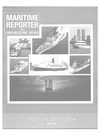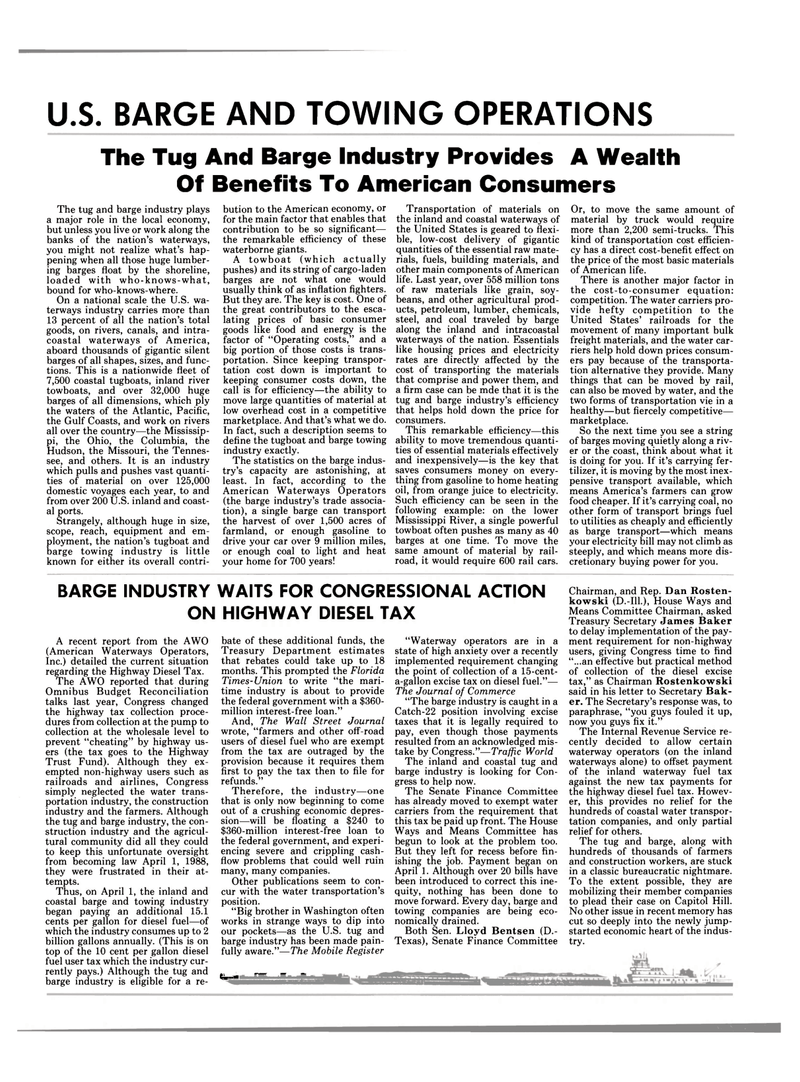
Page 42: of Maritime Reporter Magazine (June 1988)
Read this page in Pdf, Flash or Html5 edition of June 1988 Maritime Reporter Magazine
U.S. BARGE AND TOWING OPERATIONS
The Tug And Barge Industry Provides A Wealth
Of Benefits To American Consumers
The tug and barge industry plays a major role in the local economy, but unless you live or work along the banks of the nation's waterways, you might not realize what's hap- pening when all those huge lumber- ing barges float by the shoreline, loaded with who-knows-what, bound for who-knows-where.
On a national scale the U.S. wa- terways industry carries more than 13 percent of all the nation's total goods, on rivers, canals, and intra- coastal waterways of America, aboard thousands of gigantic silent barges of all shapes, sizes, and func- tions. This is a nationwide fleet of 7,500 coastal tugboats, inland river towboats, and over 32,000 huge barges of all dimensions, which ply the waters of the Atlantic, Pacific, the Gulf Coasts, and work on rivers all over the country—the Mississip- pi, the Ohio, the Columbia, the
Hudson, the Missouri, the Tennes- see, and others. It is an industry which pulls and pushes vast quanti- ties of material on over 125,000 domestic voyages each year, to and from over 200 U.S. inland and coast- al ports.
Strangely, although huge in size, scope, reach, equipment and em- ployment, the nation's tugboat and barge towing industry is little known for either its overall contri- bution to the American economy, or for the main factor that enables that contribution to be so significant—- the remarkable efficiency of these waterborne giants.
A towboat (which actually pushes) and its string of cargo-laden barges are not what one would usually think of as inflation fighters.
But they are. The key is cost. One of the great contributors to the esca- lating prices of basic consumer goods like food and energy is the factor of "Operating costs," and a big portion of those costs is trans- portation. Since keeping transpor- tation cost down is important to keeping consumer costs down, the call is for efficiency—the ability to move large quantities of material at low overhead cost in a competitive marketplace. And that's what we do.
In fact, such a description seems to define the tugboat and barge towing industry exactly.
The statistics on the barge indus- try's capacity are astonishing, at least. In fact, according to the
American Waterways Operators (the barge industry's trade associa- tion), a single barge can transport the harvest of over 1,500 acres of farmland, or enough gasoline to drive your car over 9 million miles, or enough coal to light and heat your home for 700 years!
Transportation of materials on the inland and coastal waterways of the United States is geared to flexi- ble, low-cost delivery of gigantic quantities of the essential raw mate- rials, fuels, building materials, and other main components of American life. Last year, over 558 million tons of raw materials like grain, soy- beans, and other agricultural prod- ucts, petroleum, lumber, chemicals, steel, and coal traveled by barge along the inland and intracoastal waterways of the nation. Essentials like housing prices and electricity rates are directly affected by the cost of transporting the materials that comprise and power them, and a firm case can be mde that it is the tug and barge industry's efficiency that helps hold down the price for consumers.
This remarkable efficiency—this ability to move tremendous quanti- ties of essential materials effectively and inexpensively—is the key that saves consumers money on every- thing from gasoline to home heating oil, from orange juice to electricity.
Such efficiency can be seen in the following example: on the lower
Mississippi River, a single powerful towboat often pushes as many as 40 barges at one time. To move the same amount of material by rail- road, it would require 600 rail cars.
Or, to move the same amount of material by truck would require more than 2,200 semi-trucks. This kind of transportation cost efficien- cy has a direct cost-benefit effect on the price of the most basic materials of American life.
There is another major factor in the cost-to-consumer equation: competition. The water carriers pro- vide hefty competition to the
United States' railroads for the movement of many important bulk freight materials, and the water car- riers help hold down prices consum- ers pay because of the transporta- tion alternative they provide. Many things that can be moved by rail, can also be moved by water, and the two forms of transportation vie in a healthy—but fiercely competitive— marketplace.
So the next time you see a string of barges moving quietly along a riv- er or the coast, think about what it is doing for you. If it's carrying fer- tilizer, it is moving by the most inex- pensive transport available, which means America's farmers can grow food cheaper. If it's carrying coal, no other form of transport brings fuel to utilities as cheaply and efficiently as barge transport—which means your electricity bill may not climb as steeply, and which means more dis- cretionary buying power for you.
BARGE INDUSTRY
ON
A recent report from the AWO (American Waterways Operators,
Inc.) detailed the current situation regarding the Highway Diesel Tax.
The AWO reported that during
Omnibus Budget Reconciliation talks last year, Congress changed the highway tax collection proce- dures from collection at the pump to collection at the wholesale level to prevent "cheating" by highway us- ers (the tax goes to the Highway
Trust Fund). Although they ex- empted non-highway users such as railroads and airlines, Congress simply neglected the water trans- portation industry, the construction industry and the farmers. Although the tug and barge industry, the con- struction industry and the agricul- tural community did all they could to keep this unfortunate oversight from becoming law April 1, 1988, they were frustrated in their at- tempts.
Thus, on April 1, the inland and coastal barge and towing industry began paying an additional 15.1 cents per gallon for diesel fuel—of which the industry consumes up to 2 billion gallons annually. (This is on top of the 10 cent per gallon diesel fuel user tax which the industry cur- rently pays.) Although the tug and barge industry is eligible for a re-
WAITS FOR CONGRESSIONAL ACTION
HIGHWAY DIESEL TAX bate of these additional funds, the
Treasury Department estimates that rebates could take up to 18 months. This prompted the Florida
Times-Union to write "the mari- time industry is about to provide the federal government with a $360- million interest-free loan."
And, The Wall Street Journal wrote, "farmers and other off-road users of diesel fuel who are exempt from the tax are outraged by the provision because it requires them first to pay the tax then to file for refunds."
Therefore, the industry—one that is only now beginning to come out of a crushing economic depres- sion—will be floating a $240 to $360-million interest-free loan to the federal government, and experi- encing severe and crippling cash- flow problems that could well ruin many, many companies.
Other publications seem to con- cur with the water transportation's position. "Big brother in Washington often works in strange ways to dip into our pockets—as the U.S. tug and barge industry has been made pain- fully aware."—The Mobile Register
Hm ** rt an. "Waterway operators are in a state of high anxiety over a recently implemented requirement changing the point of collection of a 15-cent- a-gallon excise tax on diesel fuel."—
The Journal of Commerce "The barge industry is caught in a
Catch-22 position involving excise taxes that it is legally required to pay, even though those payments resulted from an acknowledged mis- take by Congress."—Traffic World
The inland and coastal tug and barge industry is looking for Con- gress to help now.
The Senate Finance Committee has already moved to exempt water carriers from the requirement that this tax be paid up front. The House
Ways and Means Committee has begun to look at the problem too.
But they left for recess before fin- ishing the job. Payment began on
April 1. Although over 20 bills have been introduced to correct this ine- quity, nothing has been done to move forward. Every day, barge and towing companies are being eco- nomically drained.
Both Sen. Lloyd Bentsen (D.-
Texas), Senate Finance Committee
Chairman, and Rep. Dan Rosten- kowski (D.-Ill.), House Ways and
Means Committee Chairman, asked
Treasury Secretary James Baker to delay implementation of the pay- ment requirement for non-highway users, giving Congress time to find "...an effective but practical method of collection of the diesel excise tax," as Chairman Rostenkowski said in his letter to Secretary Bak- er. The Secretary's response was, to paraphrase, "you guys fouled it up, now you guys fix it."
The Internal Revenue Service re- cently decided to allow certain waterway operators (on the inland waterways alone) to offset payment of the inland waterway fuel tax against the new tax payments for the highway diesel fuel tax. Howev- er, this provides no relief for the hundreds of coastal water transpor- tation companies, and only partial relief for others.
The tug and barge, along with hundreds of thousands of farmers and construction workers, are stuck in a classic bureaucratic nightmare.
To the extent possible, they are mobilizing their member companies to plead their case on Capitol Hill.
No other issue in recent memory has cut so deeply into the newly jump- started economic heart of the indus- try.

 41
41

 43
43
